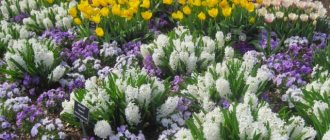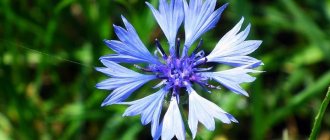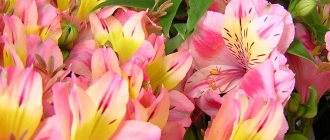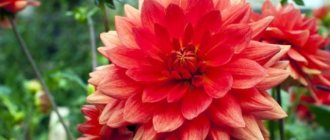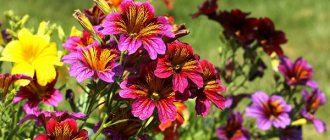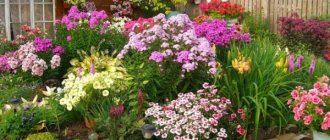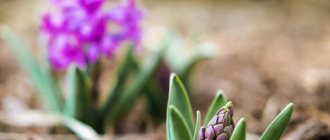Meet the annuals!
According to scientific tradition, annuals are flowers that are genetically not adapted to winter in ground conditions under snow. Such plants already die off by the winter season, leaving behind a substantial “reserve” of seeds.
However, in the short period of time allotted to them by Nature, annual representatives of the domestic flora literally “blow the mind” with their beauty, give people a lot of positive emotions, and transform city landscapes. All this, of course, can be seen in numerous photos of annual flowers.
And therefore, with the help of annuals, experienced florists and landscape designers can easily and coolly design any area of the area: coastal areas of the pond and clubs among the high-rise buildings of the metropolis, alpine hills and the edges of garden paths in the country, floor planters, areas around fountains, city embankments and much more. .
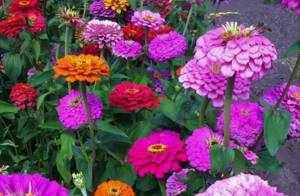
Low maintenance combined with unpretentiousness and a rich variety of bright colors – these are the competitive advantages that allow annual plants to please the eye again and again.
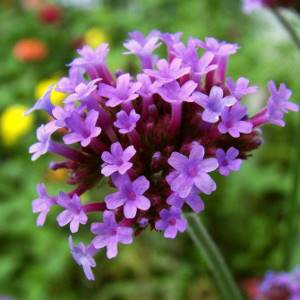
Therefore, by “making friends” with annuals, any gardener will allow himself to realize his creative needs, his creative potential literally every year.
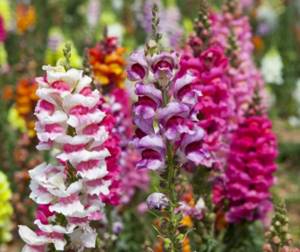
At the same time, flowers that bloom all summer will allow his summer cottage to look different every time, more interesting, or something. And new compositions created using fundamentally new varieties will always be absolutely unique, unique, and innovative.
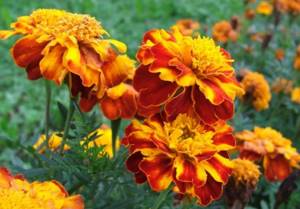
Annuals for flower beds
Flowerbed or mixborder plantings are a special pleasure for those who annually create unique compositions. Experienced gardeners begin selecting varieties long before the start of the season. The seed catalog helps you select annual flowers for flower beds, taking into account various parameters.
Marigold
The popular and beloved marigolds lead the list of long-flowering annuals. Marigold seedlings in Siberia are planted by the beginning of June. Once budding starts, it does not stop until the first frost. Marigolds produce a bright flower of orange, dark red, yellow or milky hue. The stem reaches a height of 20-30 cm.

Reference! The peculiarity of marigolds is that they are quick and easy to independently collect seeds after flowering.
Calendula
The unofficial name of calendula, which is not recorded by any professional catalog, is “marigold”. It is associated with the shape of the orange-yellow petals. The stems of calendula stretch up to half a meter, the ovaries appear when the air warms up sufficiently, and are renewed throughout the summer. Calendula is a frost-resistant species, therefore suitable for growing in Siberia.
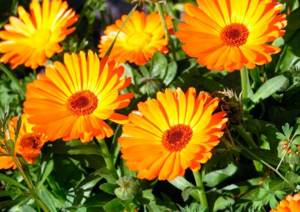
Botanists say
Botanical science categorizes annual flowers mainly by height: tall plants (from one hundred centimeters or more), medium-sized plants (from fifty to one hundred centimeters) and low-growing plants (less than fifty centimeters).
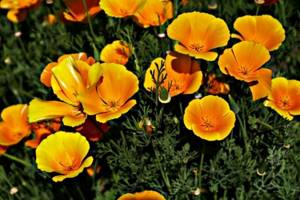
For example, tall annuals are extremely good in independent flower arrangements, and they are also very relevant in flower beds (mixborders) in the background. In this case, tall annuals are used to cover unpresentable fences and various types of buildings.
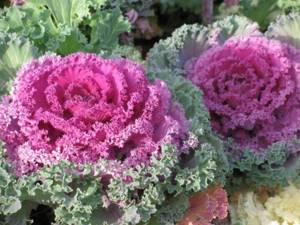
In turn, low-growing annuals are in great demand by landscape designers for the design of certain landscapes. Such flower plants are actively used both for border plantings and for decorating the foreground of mixborders, where, due to their compactness, any combination of them is used.
Low-growing annuals
Low-growing annual flowers are a group of plants intended for flowerbed plantings up to 30 cm. They are often planted along the edges of flowerbeds and used to frame or separate areas.
Lobelia
Lobelia can be grown as a perennial species, but seedlings are planted annually. Lobelia is a bush group with buds in blue, lavender or purple shades. It is customary to plant lobelia on alpine hills, create compositions in carpet flower beds, and use them on ridges. Lobelia can delight you with flowering throughout the summer. Lobelia is frost-resistant, loves sunny or shaded places, does not require nutritious soil, and can grow on loamy soils.
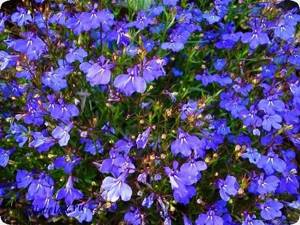
The benefits of real flowers
In addition to purely aesthetic pleasure and pleasure, annual flowers for the garden can also bring real practical benefits to the entire garden. In particular, their wonderful aroma and “scorching” color of some annuals attract pollinating insects to the dacha as much as possible. At the same time, the smell of other similar flowers, on the contrary, repels pests that are dangerous to the garden and beds.

Thus, for purely practical purposes, marigolds are successfully used, which have a specific aroma that protects against harmful insects. That’s why they are often planted close to areas where potatoes are planted. So that they repel both the Colorado potato beetle and various types of tuber pests.
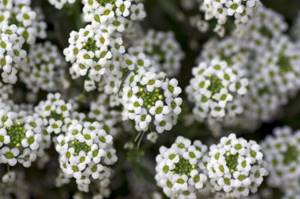
Ground cover (creeping) perennials blooming all summer: types, names, photos, description. TOP 10 best options for a summer residence
Clematis flowers - 70 photos of a beautiful flower. Planting, growing and care in open ground
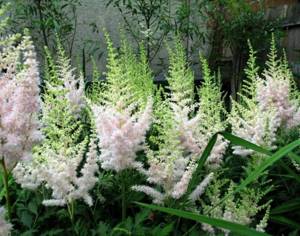
Astilbe: planting, care. growing from seeds, photos, description of species

Moreover, a number of annual flowers have remarkable healing properties that can fight many human ailments. For example, tea made from cornflower and calendula thoroughly tones the body and gives strength to the patient. In turn, tincture of calendula flowers is a classic remedy for combating throat diseases.
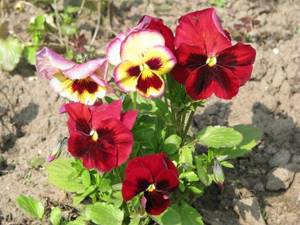
Rare annuals
The plants, which are well known in the floriculture community, are fairly easy to care for. Not everyone decides to land rare flyers, which have an unusual appearance and require special attention.
Molucella smooth
Molucella cannot be overlooked; it fits seamlessly into traditional flower beds, but at the same time retains its own individuality. On the erect stem of the molucella there are white small buds, but they are almost invisible due to the fact that each of them is surrounded by light green cups protruding above the stem. Molucella stretches up to 1 m. The plant needs sunlight and regular watering.
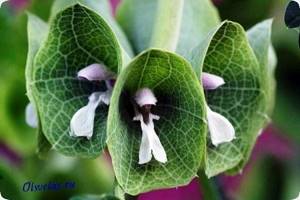
Different flower beds are important
Since annual flowers have a complete vegetation cycle that takes place in just one season, they begin to develop and bloom very quickly. In this case, the most hardy (unpretentious) for forming a beautiful flower bed are marigolds, calendula nasturtium, sage, petunias, which will absolutely bloom throughout the warm summer months.

Usually, those created from these annuals have a very specific shape (round, diamond-shaped, rectangular) and clearly defined boundaries. As a rule, flower beds are located only in one horizontal plane.

However, to diversify the surrounding landscape, experts offer other options. Among them are multi-tiered flower beds, raised and even vertical. It is noteworthy that in such “creative” flower bed areas it is the low-growing annual flower plants that will look most impressive.
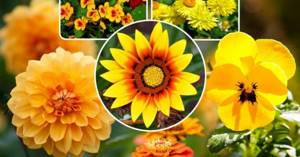
Zinnia
This daisy-like plant is a celebration of color in the area, the most attractive varieties are in sunny and honey shades.
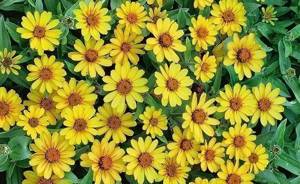
They are fragrant from June until frost. And the more dry inflorescences it loses, the more magnificently it acquires a cover of bright, cheerful heads.
This is a partial list of annual plants with beautiful yellow flowers. But even these species are enough to fill the garden plot with warm summer diversity.
Let's look at the catalog
Of course, for every summer resident, his dacha is his own little “paradise on earth,” where, perhaps, there are marvelous flower beds, alpine slides, and even paved paths with fountains. Therefore, it is quite logical that one would like to decorate such wonderful landscapes in a truly, dignified and bright way. As they say, with taste.
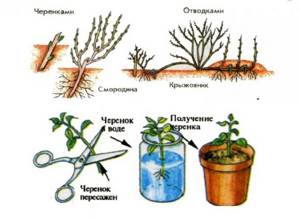
Pelargonium in open ground: planting, growing, care, reproduction, photo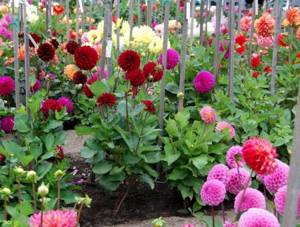
Dahlia flowers: planting and care in open ground. Photos, instructions, types, varieties, reviews

Marigolds: planting, growing, care and propagation in open ground. Overview of all types and varieties of marigold flowers
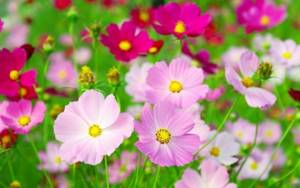
But to do this, you need to clearly imagine what you will have to decorate your dacha area with. Therefore, you should know not only the names of annual flowers, but also their biological characteristics.
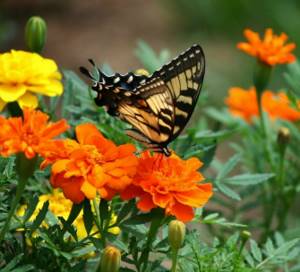
And it is for these purposes that he should look into the catalog of annual flowers, where he will find all the most complete and necessary information for the quality arrangement of his flower garden. It is in such collections that you can learn about varieties, biological characteristics, and price ranges for this or that flower product. Moreover, thanks to this newsletter, you can easily order and soon receive the annual flower seeds you are interested in.

Marigold
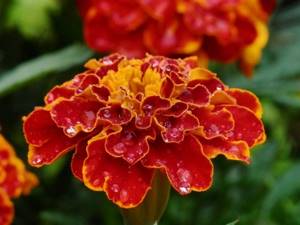
The plant of the Asteraceae family can be an annual or perennial. It grows naturally in South and Central America.
The height of marigolds varies from 20 to 150 cm. The leaf blades are pinnate, colored in all shades of green. Flowering begins in early summer and lasts until the first frost.
The flowers combine different shades of red, yellow and orange. A distinctive feature of marigolds is a strong specific smell, which comes not only from the inflorescences, but also from the leaves.
These plants are useful for the garden because they repel pests. They require virtually no maintenance and look incredibly beautiful and bright even with a minimum of care.
Flowers make you think
And over time, I finally managed to make, create, create with my own hands a real flower fairy tale. And now the multi-colored miracle pleases the eye not only with its curly realism, but also with some encrypted meaning, a sign.

After all, let’s say that the highly respected annual asters are a symbol of intelligent girls, for they are philosophical and thoughtful flowers. But annual dahlias, on the contrary, are for eccentric and frivolous people. Cute burgundy-orange marigolds, as if wanting to say: “Even though I’m a little jealous, I still trust.”
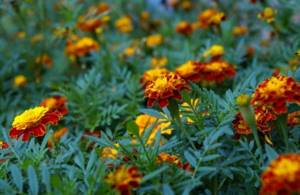
A riot of colors, charming shapes
Needless to say, many, many annual flowering plants grow in our area today. Moreover, they often drop in on us “for a glimpse” from very far away. From hot countries, overseas. For example, the ground cover plant Ageratum Houston.

Flower seedlings - ideas, selection features and secrets of placing seedlings of annual and perennial plants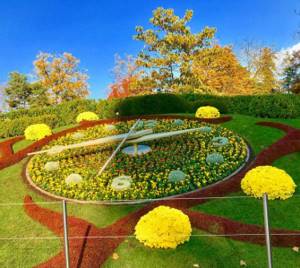
Flower clocks - designer tips, methods of use and original ideas for flower clocks (105 photos + video)
- Low-growing flowers - types, descriptions and ideas for use in landscape design (100 photos and videos)

This is a floral annual native to Mexico. As befits plants from warm countries, it grows at home for a number of years. But this is right there – the tropics! Our Ageratum Houstona is a lush annual bush with a height of about 30 centimeters. Its dense fluffy inflorescences, comfortably located at the ends of the branches, hide the emerald green of the plant behind their riot of colors (white, blue, pink, blue flowers). Thanks to this, interesting multi-colored “clouds” are formed in the flowerbed.
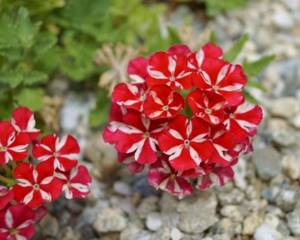
Our Mexican "amigo" blooms from June to October. It does not require high quality soil and abundant watering. The only thing he really needs is a rich sun tan.
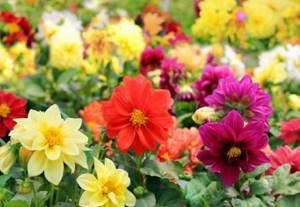
The annual Salvia flower also requires a lot of sun. Does not tolerate shade and cloudy weather well. Drought resistant. And the spike-shaped inflorescences of this plant, richly scarlet, lilac, and purple, look excellent against the backdrop of dense foliage.

The Walter's Balsam variety of annual flowers is also very popular among gardeners. Its wonderful dense greenery against the backdrop of the most delicate numerous flowers located on low round bushes certainly makes a lasting impression.
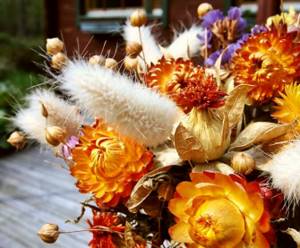
The plant can have both simple and double flowers, the color of which ranges from subtle shades of pink to amazing white. If the plant is sown in March, it will bloom in early June.
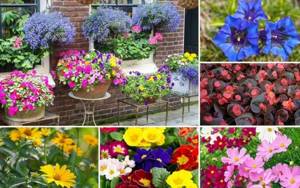
It is noteworthy that some types of nasturtium are double and very beautiful. This annual flowering plant, of course, prefers the sun, although it also feels quite confident in the shade (it’s just that in this case there will be more foliage rather than inflorescences). Nasturtiums have bright orange, red and yellow flowers that are hard to forget.
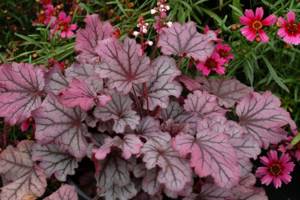
Snapdragon will also delight you throughout the summer season. It attracts attention with its rather original shape and wonderful combination of colors on the flowers, where there are yellow, white and pink. Due to its expressiveness, Snapdragon will look great in combination with other interesting plants.

Wonderful zinnias can perfectly decorate a dacha area of any size. These unpretentious annual plants will allow you to admire their longest flowering. For example, one zinnia inflorescence can bloom for up to forty days.
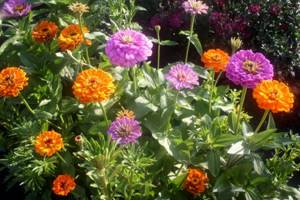
In a word, this whole emerald, soft yellow, violet, scarlet, alpine-white fairy tale tells us all: “Think and rejoice!”
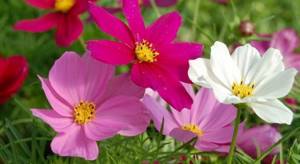
Climbing annual flowers without seedlings
If you want to beautifully decorate a garden gazebo in summer, elegantly decorate a hedge, decorate a veranda, the facade of a house, or create a green arch, climbing, unpretentious annuals will come to the rescue, which can also be grown without seedlings. They will effectively complement any architectural solution, becoming part of the original composition, and, if necessary, even hide certain shortcomings of the building.
morning glory
This decorative herbaceous vine is popularly called bindweed. It is characterized by heart-shaped or openwork leaves on long stems reaching 5–8 m. Its delicate flowers, shaped like gramophones, can be from 5 to 20 cm in diameter. Their color varies widely: milky white (in the moon-flowering morning glory), white-blue-yellow (in the tricolor), violet or pink (in the purple), heavenly color (in the blue). Flowers bloom every day in the morning and fade in the evening, but you can admire them all summer until the arrival of autumn frosts.
In our climatic conditions, morning glory is grown without seedlings as an unpretentious annual. For normal development, it needs a well-lit place, loosened calcareous soil and timely watering in the summer. You can plant morning glory without seedlings in open ground as early as early May, placing 3-4 seeds in shallow holes. The first shoots will appear in a couple of weeks.
Warning! Before planting without seedlings, morning glory seeds should be poured with hot (about 50 degrees) water and left for a day (or at least 12 hours), giving them the opportunity to swell. This is done to achieve better germination.
Sweet pea
Unpretentious, fast-growing vines, abundantly decorated in summer with clusters of five-petal flowers that look like delicate moths, are also famous for their pleasant, refreshing aroma. Varieties of this plant, which can also be grown without seedlings, are tall (Spencer, Royal groups), medium-sized (Lummer, Explorer) and dwarf (Billot, Fantasy, Cupid). The size, shape, and color of flower petals have many variations.
This unpretentious annual is planted in soil without seedlings in late April–early May (in temperate climates). It grows equally well in sun and shade in areas protected from the wind. The soil for this flower is fertile and non-acidic; in summer, good watering and drainage should be provided. Tall pea varieties also require a net or support. The plant blooms for a long time - almost three months.
Advice! Sweet peas can also grow excellently on a balcony or loggia in summer. However, you need to choose a box or flowerpot that is deep enough: the roots of this unpretentious annual should not be too crowded.
climbing nasturtium
Long (up to 4 m) lashes of decorative vines with wide, shiny green leaves are decorated with small (3–8 cm in diameter) flowers all summer until autumn, painted in the full range of “warm” shades. Their petals can be simple, double or semi-double, plain, multi-colored and even spotted. In our climate, climbing nasturtium is grown (including without seedlings) as an unpretentious annual in the sunniest areas with light composition, slightly acidic and loose soil.
If this flower is going to be grown without seedlings, its seeds are sown directly into the ground under covering material from late April to early June (depending on the climatic conditions of the region). The emergence of seedlings should be expected in a couple of weeks. Caring for this unpretentious flower consists of timely weeding, moderate watering in summer, loosening the soil and fertilizing with liquid complex fertilizers about a couple of times a month.
Important! Nasturtium is not only an ornamental, but also a medicinal plant. In addition, its leaves and fruits are also used for culinary purposes.
Dolichos
Dolichos, also known as “climbing lilac” or “hyacinth bean,” is native to the East African subtropics. In temperate latitudes, this picturesque vine is grown as an unpretentious annual. The height of dolichos is usually 3–4 m, it has large elongated leaves in the shape of a heart, and on racemose inflorescences (sometimes up to 50 cm in length) in summer grow large cream, pink, purple, white, blue or crimson flowers, similar to wisteria. The most famous varieties are “Lilac Cascade”, “Pink Moon”, “Ruby Moon”, “Purple Garlands”.
“Climbing lilac” begins to bloom in July and this process lasts until the first frost. This unpretentious plant prefers open areas of the garden, well lit by the sun. The soil for it should be fertile and loose. The key to successful growth and appearance of dolichos flowers is regular abundant watering in the summer, strong support and timely application of fertilizing.
Important! Dolichos are usually grown using seedlings. However, you can also do without it. In order not to waste time and energy on seedlings, the beans of the plant can be sown directly into the soil in May - by this time the soil is already sufficiently warmed up. But in this case, flowers should be expected no earlier than August.
Kobeya
Kobeya, a tall (up to 6 m) decorative vine with thick carved leaves and bright flowers in the shape of large bells, was given to the world by Mexico. In its homeland this is a perennial plant, but in our country it is popular as an unpretentious annual. Kobeya blooms in the middle zone from July to October, delighting the eye with large (up to 8 cm) flowers and a variegated palette of colors: snow-white, lilac, purple, light green, burgundy.
This unpretentious plant prefers warm sunny places (although light shade is possible), as well as soft, loose, lime-rich soil with neutral acidity. Watering should be abundant and regular, especially in summer, in dry, hot weather.
Kobeya is extremely rarely grown without seedlings. However, this method is also practiced, especially in warm regions of the country. To do this, you should wait until the soil warms up well, and after sowing the seeds in the soil, you must cover the area with a double layer of film or non-woven material. Seeds planted directly into the soil without seedlings will sprout in the summer, not earlier than June, and the flowers of these plants will appear 1.5–2 months later than those of kobei planted as seedlings in the soil.
Important! It is problematic to independently collect kobe seeds for planting next year in our latitudes. As a rule, they simply do not have time to ripen. If you want to plant this flower - without seedlings or with the help of a seedling - next season, you will have to buy ready-made seeds again.
